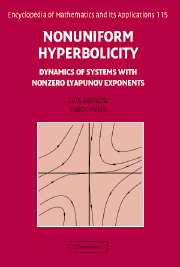Introduction
Published online by Cambridge University Press: 05 May 2013
Summary
The goal of this book is to present smooth ergodic theory from a contemporary point of view. Among other things this theory provides a rigorous mathematical foundation for the phenomenon known as deterministic chaos – a term coined by Yorke – the appearance of highly irregular, unpredictable,“chaotic” motions in pure deterministic dynamical systems. The main idea beyond this phenomenon is that one can deduce a sufficiently complete description of topological and ergodic properties of the system from relatively weak requirements on its local behavior, known as nonuniform hyperbolicity conditions: the reason this theory is also called nonuniform hyperbolicity theory.
It originated in the seminal works of Lyapunov [134] and Perron [164] on stability of solutions of ordinary differential equations. To determine whether a given solution is stable one proceeds as follows. First, the equation is linearized along the solution and then the stability of the zero solution of the corresponding nonautonomous linear differential equation is examined. There are several methods (due to Hadamard [79], Perron [165], Fenichel [70], and Irwin [92]) aimed at exhibiting stability of solutions via certain information on the linear system. The approach by Lyapunov uses a special real-valued function on the space of solutions of the linear system known as the Lyapunov exponent. It measures in the logarithmic scale the rate of convergence of solutions so that the zero solution is asymptotically exponentially stable along any subspace where the Lyapunov exponent is negative.
Information
- Type
- Chapter
- Information
- Nonuniform HyperbolicityDynamics of Systems with Nonzero Lyapunov Exponents, pp. 1 - 6Publisher: Cambridge University PressPrint publication year: 2007
